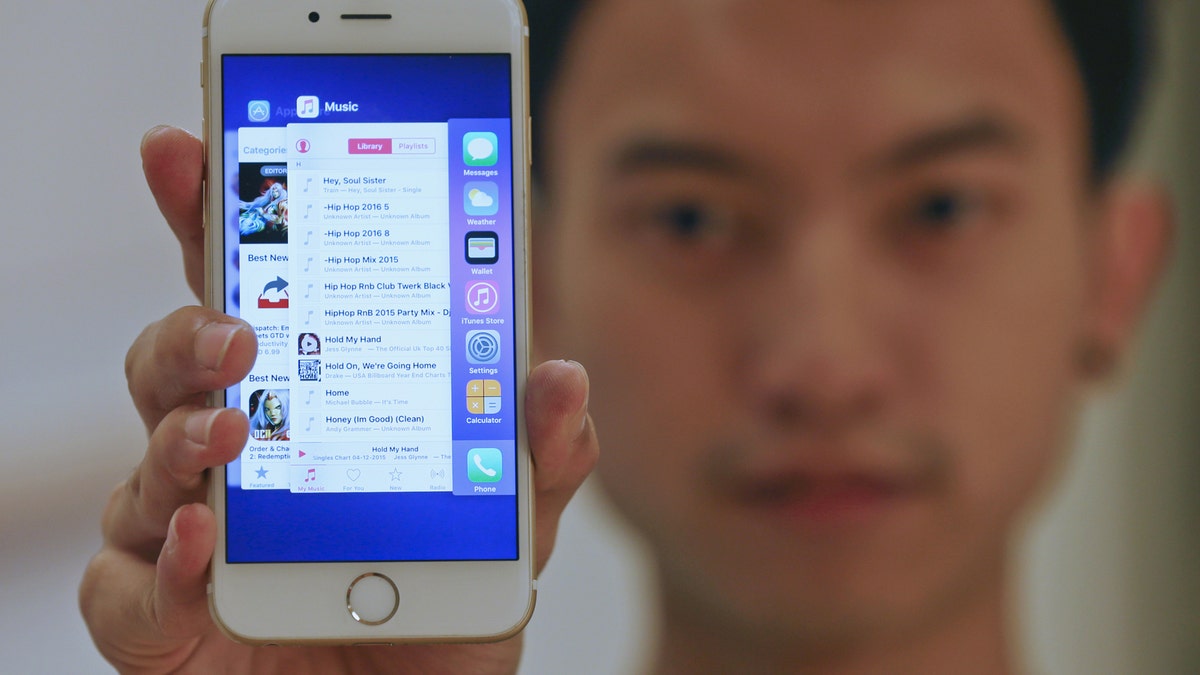
File photo: A sales assistant shows features of iOS 9 on an Apple iPhone 6 at an Apple reseller shop in Bangkok September 18, 2015. (REUTERS/Chaiwat Subprasom)
Oh, autocorrect! Sometimes you’re so handy. You see the word “brain” and you know I meant “Brian.” You instantly switch letters around, turning nonsense into coherent words. You complete me – or, more accurately, you complete my sentences.
So why do you have to drive me crazy? Why do you take the words I intend to type and completely rearrange them? Why must you always turn “Missy” into “Mossy,” or “so” into “do,” or “well” into “we’ll”? Why can’t you just accept the things I type into that tiny keyboard, except when I obviously intend something else?
Tip in a Tip: If you really want to take control of your iPhone, click here for power tips you’ll wish you’d known from Day One.
Most autocorrect errors are funny, like a digital Mad Libs. But sometimes we send messages without realizing how embarrassing they are.
Here’s the good news: You actually have a lot of power over the autocorrect feature on your iOS device.
After all, your iPhone and iPad are trying to learn from you. There are several tactics you can use to prevent misunderstandings, and I guarantee that any of them will work wonders.
Turn off autocorrect
Yes, you can just turn it off. Autocorrect may seem like a permanent fixture, but you can actually disable it whenever you like. No more bad guesses. No more awkward miscommunications. You simply type what you mean, letter by letter, and if something is misspelled, so be it.
Just tap Settings >> General >> Keyboard, then toggle Auto-Correction to Off. Follow the same steps to turn it back on if you need it again.
Reset your keyboard dictionary
Deep inside your phone, there is a tiny dictionary, a verbal database that determines whether your words are spelled correctly. Everything you type is checked against this list. But the more you use your phone, the more you may accidentally save words to the dictionary that aren’t correct. Over time, these misspellings can add up, meaning more frustration for you.
Luckily, you can essentially “reboot” your keyboard’s dictionary. Just go to Settings >> General >> Reset, then Reset Keyboard Dictionary. Once you’ve done this, your dictionary is a clean slate, the same as when you bought your phone. Now you can begin
“training” autocorrect to respond to your preferences, and all of those misspelled words will have magically been erased.
Train autocorrect as you go
When you misspell a word in iOS, autocorrect usually jumps in with the correct spelling. It can also fill in words it recognizes before you fully type them. Just hit the spacebar or tap your finger on the word to accept the autocorrect suggestion.
But this can also be frustrating. You’ve probably done this a thousand times: iOS guesses the wrong word, over and over. By the time you’ve typed the full word “marginal,” iOS has already guessed “My,” “Maybe,” “Man,” “Mary,” “Maria,” “Math,” “Marge,” “Margi,” “Margo,” “Margin,” “Margins,” “Marginally” and “Marginalized.” If you hit one of these guesses by accident, you have to delete letters and go back.
Meanwhile, iOS may think it’s guessing correctly, especially if you accidently press the spacebar. This will cause autocorrect to learn from a mistake, which could cause problems later on.
To counter this, start typing your word, and when autocorrect guesses the wrong word, tap the X in the autocorrect bubble and override the suggestion. This slows you down a little at first, but iOS will learn your preferences very quickly and will stop suggesting it.
Text replacement
If you’re feeling ambitious, you can program your phone to replace one phrase with another. These shortcuts can be very handy and save you a lot of typing time.
Here’s a typical example: You want to say, “On my way,” but instead you type “OMW.” With one little trick, your phone can automatically turn “OMW” into “On my way.” Or you could turn “BRB” into “Be right back,” or “1234” into “Four Score and Seven Years Ago.” Anything you feel like.
Here’s what you do: Go to Settings >> General >> Keyboard >> Text Replacement >> Tap the + sign. Here, you add the complete sentence to the Phrase field — in this case, “On my way.” In the Shortcut field, you put “OMW.”
But there’s also the flip side: If you leave the Shortcut field blank, autocorrect will stop trying to correct the spelling of that word or phrase. From now on, you can type that word and autocorrect will theoretically ignore it.
Turn off predictive text
As you type, you’ll notice words popping up between the keyboard and the text. This feature is called “predictive text,” because your phone is trying to guess the next word you want to type. Because your phone learns from your vocabulary, predictive text should become more accurate as time goes on.
But the opposite is also true: When you make mistakes, predictive text starts guessing incorrectly, because it is using incorrect data to anticipate your word-choice.
One nice thing about predictive text is that you can easily toggle while typing to turn it on and off.
Here’s how you do it: Open the Messenger app, press and hold the keyboard button (where you enable your emojis) and toggle on (or off) the “Predictive” option.
Alternatively, in iOS 10, got to Settings >> General >> Keyboard >> then toggle the “Predictive” option to Off.
What other bad smart phone habits can you tame? Be sure to listen to or download my podcasts, or click here to find them on your local radio station. You can listen to the Kim Komando Show on your phone, tablet or computer. From buying advice to digital life issues, click here for my free podcasts.
